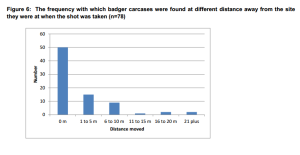But Jill, a fortnight is two weeks not three.
Shut up, that’s what.
This week I want to discuss two main studies – the first by Torgerson and Torgerson (2010) and the second a 2008 in the Veterinary Record. We have talked about why the disease is a problem, why the cull hasn’t worked, so the question becomes: What now?
The Torgersons start off with the claim that Defra’s continual fight against bovine tuberculosis is a misplaced use of public resources and we should just chill on the whole thing.
What’s their reasoning?
They start by going into the details of the few cases Britain has had of humans developing bovine TB. Between 1993 and 2003 they note that there were only 315 human cases of Bovine TB and only 14 of those were in people born after 1960 and were British Nationals.
Molecular investigation found that only 10 of the 25 spoligotypes of the bovine TB present in infected humans were actually present in contemporary UK cattle. They describe two cases from Gloucestershire where on-farm transmission from cattle to humans was likely. A third case in Cornwall where a veterinary nurse was infected was considered to have more likely come from her dog. (Interestingly, cats and ferrets are also known vectors of bovine TB and I know I’ve had more cats sneeze into my mouth than badgers, and I’ve probably worked with more badgers than most . . . Ragg et al, 1995). The more infamous six cases which sprouted up in Birmingham featured a UK national with a ‘history’ of drinking unpasteurised milk at home and abroad. And four of these six patients were likely immunocompromised.
Historically, Bovine TB did not come from cattle-to-human airborne transmission, but through milk. And as we pasteurise all our milk nowadays, the Torgersons conclude this risk is now negligible. I want to take a moment to say that I have anecdotally observed a strange counter culture of people who love unpasteurised milk (in fact it is a topic of conversation that seems to leap up whenever I tell people I work with dairy cows). Unpasteurised milk drinkers are a little like foodies who insist you’re using the wrong kind of spice and I’m often asked if I drink unpasteurised milk – once I was fairly certain my optician wouldn’t sell me glasses until I converted to unpasteurised, but I digress – seeing as milk makes me ill at the best of times, the thought of drinking milk unpasteurised ‘gies me the boak’ as we say in Glasgow. Unpasteurised cheese is another matter . . .
Where was I?
Oh yes. The end conclusion of the Torgersons (are they brothers, or did they just think they would be epic scientific partners?) paper is that they believe our hypervigilant position on bovine tuberculosis in the UK is a waste of public resources. They don’t see a reason for spending so much money on a disease which so rarely affects humans.
The Veterinary Record article doesn’t quite agree, but following the randomised badger culling trial in 2007, they too realised that badger culling was not the way forward (yes we were having this discussion seven years ago) . In the article they propose:
- More frequent testing of cattle using combined tests to detect active disease.
- Research on post-movement cattle testing.
- Research into a vaccine for cattle and badgers and immediate usage as soon as its developed.
- Research into the disease.
- Get farmers to understand the need for greater on-farm biosecurity.
Really, this article back in 2008, was proposing the oldest solution: identify, research, prevent.
So why aren’t we there yet? Well seven years in research and pharmaceuticals is not a lot of time. Defra’s old website has a page on cattle vaccinations and it points out that the EU prohibits vaccinating cattle against TB (because being vaccinated makes some cattle test positive for TB, ergo herds cannot be declared TB free because the vaccine may be masking infection. The EU prohibits trade of TB infected cattle).
The BCG vaccination is not brilliantly effective in cattle, so we either need a better vaccine, or to use that vaccine to protect some of the herd and reduce the number of cattle we need to cull. But it’s expensive and hampers trade with the EU.
This post will be published a week after I voted in the European elections. I can tell you I didn’t vote for UKIP or anything like that, I’m a good left winger who lives in Scotland, you get three guesses on my vote and the first two don’t count, but the role of the EU legislation in our Bovine TB problem can’t be ignored. The Farmers Guardian reports that the European Commission doesn’t expect a vaccine to be around until 2023.
There is definitely something to be said for better biosecurity measures on farms. There are some brilliant farmers, and there are some poorer farmers, and coughs and sneezes spread diseases. We have known this since Koch came up with his postulates. The good farmers resent being told what they already know and the poor farmers resent being told to do better. We come back to my old hobby horse – how do you communicate that science to a varied audience?
And finally the TB test – if we can find a test that can discriminate between infected, active infections, vaccinated and TB free, and do so reliably, we can still trade with the EU. These things all take time, money, and a little bit of luck.
We won’t find the solution to the bovine TB problem on a welfare scientists hobby blog. The answer is not badger culling. It’s not, as the Torgersons suggest, just letting the disease roam free. If we want to trade with the EU we need to deal with it.
Just wait till Defra finds out cats transmit TB . . .



